Abstract
The transformation and upgrading of traditional agriculture are required to address its shortcomings and deficiencies, which have resulted in environmental pollution or water problems. Precision agriculture emerged at the historic moment to solve the current problems. Field information collection, information management and decision-making, and execution systems are the three key links of precision fertilization and irrigation. The technical principle and application of field information acquisition systems are analyzed. The information management and decision-making system describes the management and summary of information in crop growth. The execution system combines the knowledge of various disciplines and experts for targeted applications to specific crops. It further focuses on the core implementation system, that is, variable fertilization technology and variable spraying technology that can realize variable operations. Major contributions from different countries, institutions, corresponding authors, and journals are presented in detail. This study proposes several suggestions and ideas based on the research status and progress of the three key systems to provide a theoretical basis and technical support for the research and development of key technologies and innovative devices of precision agricultural fertilization and irrigation.
1. Introduction
The environmental and resource problems caused by fertilization and irrigation in traditional agriculture have become increasingly serious, thereby hindering the realization of sustainable agricultural development goals in China. In the context of changing international situations and frequent natural disasters, traditional agricultural production methods are in urgent need of transformation and upgrading driven by emerging technologies, such as artificial intelligence, Internet of Things, and cloud platforms [1,2]. Precision fertilization and irrigation technology is emerging as the times require and is becoming an effective means to achieve green and efficient global agriculture. Precision fertilization and irrigation technology, supported by information technology, is a new type of agriculture that comprehensively integrates information technology and agricultural production by positioning, timing, and quantitative implementation of a set of modern agricultural operation and management systems in accordance with spatial variation [3,4].
Food security depends on agriculture, and agricultural security depends on water security and fertilizer security. Irrigation water resources are scarce, and fertilizer pollution is serious [5]. In the current greenhouse production process, excessive consumption of pesticides, fertilizers, and irrigation water leads to a low utilization rate of resources and a high content of liquid nitrate discharged from irrigation, resulting in the pollution of groundwater resources [6,7]. Fertilizers with low efficiency are used heavily in many areas to increase crop yields [8]. Although yields are relatively high, crop quality and income are low in some cases, and excessive fertilization causes a large amount of wastewater and pollution [9]. Precise irrigation management requires data and information from crop growth conditions, soil physical and chemical properties, weather factors, and the interaction among these factors. The effective implementation of precision irrigation requires a comprehensive decision support system to process and integrate data and information at different levels [10].
The growth of crops mainly depends on the supply of nutrients and water. Precision fertilization and precision irrigation have always been a research hotspot. With the progress of science and technology, precision fertilization and precision irrigation have emerged after in-depth research. Field information collection, information management and decision-making, and execution systems are the necessary links to realize precision agricultural machinery. Field information collection technology is the first step to achieve precision agricultural fertilization and irrigation. The principles and applications of a grid format survey, Global Positioning System (GPS) monitoring, remote sensing monitoring, and wireless sensor automatic monitoring technologies are analyzed. The above technologies are used to collect information on crop survival environments and growth conditions for grasping the dynamic changes in crop growth and using the information rationally. Information management and decision-making systems are at the heart of precision fertilization and irrigation. Their principles and applications are analyzed in terms of precision decision making and management technologies, respectively. These systems are responsible for the rational analysis and integration of the collected information and making decisions based on the information. The execution system is an important component of precision fertilization and irrigation. Variable fertilizer application and variable spraying technologies are the two essential technologies of this system, and their principles and applications are analyzed. The above technologies are applied to achieve the final variable fertilization and irrigation operation of the crop. The above three links are used sequentially, interlocked, reasonably regulated, and coordinated with each other to realize precision fertilization and irrigation, as shown in Figure 1.
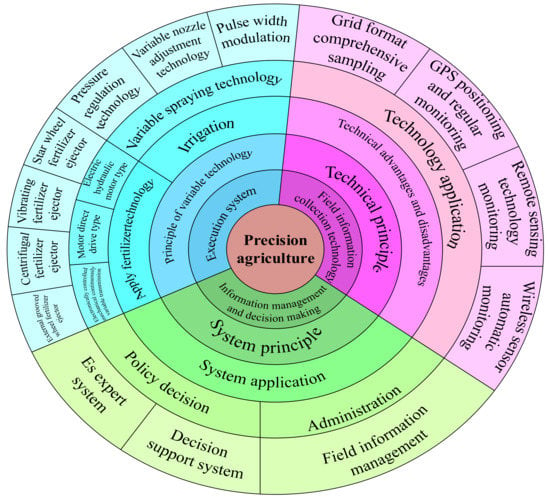
Figure 1.
Article structure chart.
At present, the traditional operation mode is costly, inefficient, and may lead to the decline of crop yield, low quality, and environmental pollution. The application of variable technology and equipment in crop production can greatly improve crop yield and resource utilization and reduce environmental pollution. The supporting devices of field information acquisition, information management and decision-making, and execution systems are an important basis for the development of intelligent agricultural machinery industry. However, the variable technology and device level of intelligent agricultural machinery in China lag behind compared with developed countries. To improve the technical level of China’s intelligent agricultural machinery variable technology, Chinese researchers from domestic agricultural machinery departments and various colleges and universities have analyzed and studied foreign advanced agricultural machinery variable technology. They independently innovated and designed relevant mechanical equipment that has been preliminarily applied in production, but they cannot produce large-scale benefits. No mechanical equipment is available to support the intelligent agricultural machinery in China, and many key technologies need further study.
This study summarizes and reviews systematically the system mechanisms and applications corresponding to each of the three key aspects of precision fertilization and irrigation: field information collection, information management and decision-making, and execution systems. The main contributions from different countries, institutions, corresponding authors, and journals are presented in detail. They are expected to provide a theoretical basis and technical support for the development of key technologies and innovative devices for precision fertilization and irrigation.
2. Field Information Collection
The field information acquisition system is the fundamental premise of implementing precision fertilization and irrigation. The sensing and acquisition of biological characteristic parameters and growth environment information of agroforestry plants are an important basis for precision fertilization and irrigation [11,12]. Basic farmland information has a decisive influence on crop growth and final yield. A high-density, high-resolution, fast, and low-cost information acquisition technology scheme is of great importance for the application and promotion of precision fertilization and irrigation [13,14]. Farmland information acquisition technologies mainly focus on farmland soils, crops, micrometeorology, pests and diseases, and extreme disasters. The mainstream acquisition methods include conventional field surveys, regular monitoring based on GPS positioning, remote sensing and unmanned aerial vehicle (UAV) multisource image monitoring, and wireless sensor automatic monitoring [15,16,17]. Field information can be roughly divided into soil attribute, location, crop growth, farmland surrounding environment, and crop yield information [18,19,20]. It has the characteristics of large quantity, multidimensional, dynamic, uncertain, incomplete, sparse, and strong temporal and spatial variability. At present, research on rapid field information acquisition technology is still relatively undeveloped and has become an important topic in many international units [21,22].
2.1. Principles
- (1)
- Conventional field investigation usually adopts the network format (arranging and creating relationships between elements in a vertical and horizontal distribution) for comprehensive sampling investigation, focusing on laboratory tests and analyses of soil information. A sampling grid is set in accordance with the requirements of precision fertilization and irrigation. This method costs considerable manpower and material resources and is usually used as the basic evaluation of a certain plot [15].
- (2)
- GPS positioning is monitored regularly. The sampling points are located through the GPS and introduced in the geographic information system (GIS), which can realize the spatial vectorization, interpolation, and visualization of the whole farmland plot and provide an important reference for the scientific management of farmland information and the formulation of farming plan. At present, relatively mature technologies are found in this regard [15,23]. Farmland location information mainly includes the longitude and latitude of the sampling point, and the shape and area of the field, which is mainly obtained by global positioning technology. GPS is used to collect information in the field, so as to form a fertilization and irrigation prescription map. If multiple known points are found, then the method of resection can be used to obtain the coordinates of an unknown point. GPS collects some farmland information and provides real-time location information for agricultural machines and tools to guide accurate property management [18,24]. The traditional work of surveying and collecting information on agricultural land is usually stored on paper, which is unconducive to finding and reading information and to keeping and storing information, and cannot be analyzed and tabulated. Agricultural production information and geographic information can be organically combined by using GIS technology to provide unprecedented spatial and temporal characteristics for all types of agricultural information [25]. Existing soil and crop information data are sorted and analyzed by the GIS as attribute data; an efficient and operational field management system can be created by combining them with the vectorized basemap data [18].
- (3)
- High-precision, real-time remote sensing imaging technologies, such as UAV and 3D laser scanning, are introduced to provide more accurate and powerful technical support for precision fertilization and irrigation decision-making services [26,27,28,29,30]. Remote sensing technology refers to detecting and identifying electromagnetic energy and accurately obtaining various field information without direct contact between the sensor and the object [31]. Sensors installed on satellites, aircraft, or ground equipment [32] can be adopted in the application of remote sensing in precision fertilization and irrigation. Collecting and analyzing information on crop and soil characteristics, obtaining information on spatial and temporal changes in agricultural land, predicting crop yields, and accurately reporting the agricultural situation are all essential operations [33]. The remote sensing system obtains the data for each period of the whole process of agricultural production for monitoring soil and crop moisture, crop nutrition, crop diseases, and pests [34,35]. Precision fertilization and precision irrigation use remote sensing and telemetry technologies to accurately grasp the spatiotemporal differences in soil, water, fertilizer, diseases and insect pests, and crop yields, which maximize the economic and ecological benefits with minimum production input [36]. The popularization of laser measurement technology has greatly improved the efficiency of the measurement and collection of basic farmland information. The use of laser measurement technology can realize the real-time measurement of relevant data, such as the length, area, and regional elevation of agricultural production areas. The miniaturization trend of measurement equipment enables it to be applied to more measurement carrier platforms, such as UAVs, unmanned ships, and mapping vehicles, which further improves the speed and accuracy of surveying and mapping [37]. However, the information obtained from remote sensing, such as soil moisture and crop canopy biochemical parameters, is not directly used for precision fertilization and irrigation. The relationship between remote sensing information and parameters related to soil and crop growth states needs to be established through analysis, which is the “bottleneck” restricting the application of remote sensing information in agricultural information acquisition [38]. Remote sensing technology is an important source of field data in the future precision agriculture technology system. It can provide a large amount of field temporal and spatial change information. The application of remote sensing technology in precision fertilization and irrigation mainly includes: (i) Monitoring of crop growth and its background: high-resolution (meter resolution) sensors are used to implement comprehensive monitoring in different crop growth periods, and spatial qualitative and positioning analyses are conducted in accordance with spectral information to provide a basis for positioning agriculture. (ii) Crop canopy multispectral monitoring: the information obtained by ground object spectrometer and multispectral camera is used to monitor the change in chlorophyll density and analyze the relationship between its change and nutrients. (iii) Multispectral remote sensing information (infrared band) is used to monitor soil moisture under crop conditions [39,40]. Spectral images can be used to determine the field leaf area index and ground cover plants, which is helpful to yield prediction.In the field of agriculture, the most commonly used remote sensing technologies include optical remote sensing and thermal remote sensing [41]. Optical remote sensing uses visible light to create an image of the Earth’s surface by detecting the energy reflected from the surface of the target area [42]. It has been successfully applied to estimate various plant parameters, such as leaf area, plant cover, biomass, and chlorophyll content. The largest disadvantage of optical remote sensing is the slow response of these variables, which are usually adjusted only when plants have obvious stress damage [43]. Thermal remote sensing is a process of measuring the radiation emitted from the surface of an object and converting it into temperature without establishing direct contact with the object. Crop canopy surface temperature is a function of transpiration rate and a function of atmospheric evaporation and crop available soil water status. Pressure in crops (water, weeds, and nutrients) will affect their canopy temperature, which can be measured at key stages for managing and optimizing agricultural production and inputs [44].
- (4)
- Automatic monitoring by wireless sensor. A remote automatic monitoring method integrating sensors, microprocessors, and wireless communication can greatly reduce the consumption of human and material resources in the implementation of precision fertilization and irrigation and has become one of the hot spots in the field of agricultural informatization and intelligence [45,46]. The real-time sensor technology has been widely used in variable spraying due to its high precision and strong real-time performance. The spray target profile, location, density, and other information are acquired in real time by using a variety of sensors (such as vision, ultrasonic, infrared, and laser sensors) through the analysis and processing of the control system to determine the spray water and form the spray decision. However, this technology is still affected by some factors and still has a high misjudgment rate in recognition, especially in complex environments where the recognition ability is unsatisfactory and the recognition accuracy can still be improved [47,48].
Table 1 shows a comparison of the advantages and disadvantages of various field information collection.

Table 1.
Comparison of advantages and disadvantages.
2.2. Examples of Concrete Implementations
Examples of soil information management, crop growth information, pest and weed information, and farmland environmental information acquisition are listed in Table 2 [49,50,51,52,53,54,55,56,57,58,59,60,61,62,63,64,65,66]. The methods and techniques used are analyzed, and the data obtained and the development of precision fertilization and irrigation are briefly summarized. The field information collection method improves the yield and economic efficiency of crops, and the farming environment.

Table 2.
Field information collection method.
- (1)
- GPS technology. In 2021, Huang designed a rice soil nutrient detection system based on GPS technology. The system data acquisition module is mainly composed of a single-chip microcomputer system board, various measurement modules, and external interfaces. The structure is shown in Figure 2. The system can complete the detection of various nutrient data of rice soil and can access the monitoring data online. It has strong operability, high reliability, and certain popularization value [67,68]. Wu designed a high-precision positioning system of agricultural plant protection UAV based on GPS and satellite navigation system and comprehensively analyzed the specific software and hardware implementation. The system was tested. The test results show that the designed system can effectively meet the requirements of UAV for accurate positioning [69].
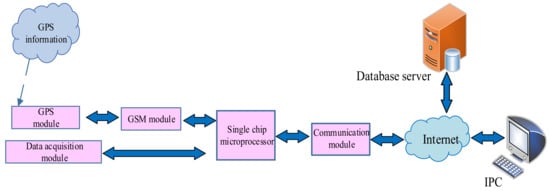 Figure 2. Overall structure diagram of a detection system.
Figure 2. Overall structure diagram of a detection system.
- (2)
- Remote sensing technology. Ma et al. evaluated the vegetation index, surface temperature, and reflectance characteristics of each band in the image through remote sensing and constructed a prediction model of powdery mildew during the wheat filling period by using the remote sensing meteorological characteristics. The overall accuracy of the model prediction reached 84.2% [45]. Ma et al. performed spectral determination of the diseases and pests of fruit trees and Lycium barbarum by using remote sensing near-earth hyperspectral technology [70]. Li et al. realized the collection of dead wood position information through small UAV remote sensing technology [71]. Yuan et al. used remote sensing and GIS to analyze the highly complex information environment under the current mode [72]. Liu et al. used hyperspectral remote sensing technology to find the best density of grain maturer [73].
- (3)
- Wireless sensor technology. Wang investigated the detection of lateral cypress moth damage based on gas-sensitive sensor technology, selected the characteristic components of the volatiles of the pest-affected lateral cypress, and realized the detection of lateral cypress damaged by different pest types using a homemade gas-sensitive sensor, thereby providing a reference for the application of gas-sensitive sensors in moth damage detection [74]. Rui presented a new method called magnetic resonance measurement technology that can quickly and quantitatively measure soil moisture. Free water and bound water in soil have different attenuation laws of transverse relaxation time. A method of analyzing the magnetic resonance echo signal is proposed; it can distinguish the components of free water and bound water in soil. Experiments show that the magnetic resonance sensor has a sufficient signal-to-noise ratio and resolution to accomplish the sensor tasks [75]. For the acquisition and reconstruction of plant 3D information, Liu et al. used Kinect sensor technology to achieve greenhouse hanging basket plant measurements and 3D reconstruction and depth and area information measurements. This method can be further extended and applied to the 3D reconstruction and measurements of other irregular plants, so as to realize the collection and processing of plant information in the process of real-time monitoring of agricultural plant growth states based on a Kinect sensor and serve as a reference for Kinect 3D sensors. The precise application of fertilizers and a timely control of diseases and insect pests can be achieved [76].
3. Information Management and Decision-Making System
3.1. Principle
Accurate decision-making technology refers to appropriate processing and processing (data analysis technology) after collecting the overall situation of relevant farmland (using data acquisition technology). These data must be analyzed to obtain the best crop management decision-making scheme (accurate decision-making technology). The key to success is timely access to information and careful decision making. Precision fertilization and precision irrigation are directly related to farmers’ decision making. In agriculture, these can make correct decisions for farmers in terms of farm management, so it can be described as the brain that converts data into decision making [41]. The decision support system (DSS) is widely used in agriculture and is a system based on a computer to support agricultural decision making [77,78]. Expert systems are computer systems that apply computer technology to simulate the idea of experts in dealing with the problems that experts can solve. They have a dominant role in dealing with qualitative knowledge [79].
The information management and decision-making system uses computers to manage and analyze huge amounts of crop production data, which saves considerable manpower, avoids unnecessary human errors, and facilitates the query and application of data. The use of the simulation function of computer software for simulation prediction can guide production more accurately and quickly, improve the accuracy and efficiency of prediction, and enhance the predictability of production [80,81]. Precision fertilization and precision irrigation are the inevitable results of the development of modern agriculture. It is a new advanced agricultural technology and is an important part of information agriculture and the concretization of the integration of multidisciplinary technology systems. Research on various integrated systems (GIS and RS, GIS and GPS, and GIS and DSS, etc.) must be strengthened, and their depth and breadth must be continuously developed in some original application directions to improve their practicability and develop China’s applicable precision fertilization and irrigation technology and application systems [82,83]. Figure 3 shows the ecosystem of information management and decision-making system.
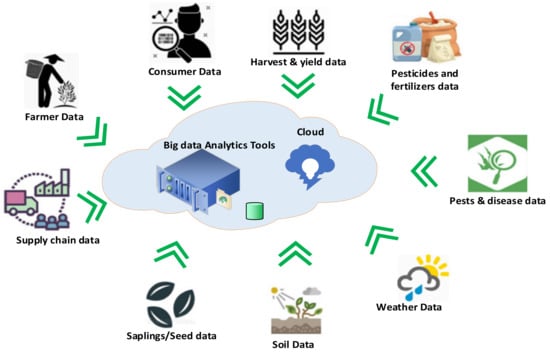
Figure 3.
Information management and decision-making system.
3.2. System Application

Table 3.
Application of decision systems.
Feng et al. constructed a cotton digital information management decision-making system with farmers as the basic unit based on WebService technology by comprehensively using the Chinese cotton production prosperity index model (CCPPI) and Chinese cotton growth index model (CCGI). The system can dynamically release cotton growth information, spatial change information, and management decision-making plan so as to realize rapid monitoring and evaluation and efficient management of face-to-face production [80]. Using knowledge engineering and system modeling methods, Liu et al. established quantitative dynamic knowledge models for planting system evaluation, agricultural product ecological zoning, agricultural production potential analysis, and accurate agricultural management. Using software component technology, a networked and digital agricultural spatial information management and auxiliary decision-making system was established. The system realizes the functions of basic map operation, agricultural spatial information query and analysis, planting system evaluation, agricultural product ecological zoning, agricultural production potential analysis, accurate agricultural management, and visual output and system maintenance. The experimental results show that the system can effectively manage regional agricultural spatial information and has good adaptability and guidance in agricultural production management decision making based on spatial information [87]. Cao et al. established a fertilization model, case base, expert knowledge base, and fertilization decision scheme based on regional soil fertility differences, fertilizer supply performance, and fertilizer utilization rate, etc. and constructed a fertilization management decision system for Fan tobacco production. It realizes the integration of farmland and crop production information management and intelligent fertilization decisions, as well as fast and efficient online access. The results show that the system can provide users with a scientific and reasonable fertilization program, and the amount of fertilization can be more accurately controlled. Moreover, RIA/REST development frameworks are characterized by flexible deployment, easy development, strong scalability, and more advantages in user experience and interaction [88].
4. Execution System
4.1. Variable Rate Fertilization Technology
4.1.1. Principle
Variable control technology is the most important research direction, and the development of equipment to control variables is the key to realize precision agricultural machinery [89]. Variable rate fertilization equipment is an important research content of controlling fertilization variables. Precision fertilization and precision irrigation are a fertilization technology based on the comprehensive analysis of the yield data of different spatial units and multilayer data, such as soil physical and chemical properties, diseases, pests, and climate. This technology is supported by the crop growth model and crop nutrition expert system and intended for high yield, high quality, and environmental protection. The nutrient balance of an agricultural platform system must be investigated [90,91,92,93,94,95].
The core performance of variable rate fertilization equipment is to achieve high fertilization accuracy. At present, China has developed suitable variable rate fertilization mechanisms based on foreign advanced automatic control. Variable rate fertilization mechanisms can be divided into three types: electronic mechanical stepless transmission type, electronic–hydraulic motor type, and motor direct-drive type, as shown in Table 4. Many types of fertilizer ejectors are used in variable rate fertilization devices, including the outer grooved wheel type, centrifugal type, vibrating type, and star wheel type, as shown in Table 4 [96,97,98,99,100,101,102,103].

Table 4.
Variable rate fertilization mechanisms with different driving types.
- (1)
- The outer grooved wheel fertilizer metering device, which is based on the outer grooved wheel seed metering device, increases the diameter of the grooved wheel, reduces the number of teeth, and increases the volume of the inter groove (Figure 4). It is characterized by a simple structure and good fertilization uniformity. This metering device is applicable to loose chemical and compound granular fertilizers with good fluidity. However, it is susceptible to hollowing and breaking when powdered or wet fertilizers are applied. The amount of fertilizer discharged is shown in Figure 4 [97,104,105,106].
 Figure 4. External grooved wheel fertilizer ejector.
Figure 4. External grooved wheel fertilizer ejector.
- (2)
- The centrifugal fertilizer ejector uses the rotating disk at the bottom to scatter fertilizer particles under the action of centrifugal force. It is mainly applicable to granular and powdery fertilizers with good fluidity. The rotating disk at the bottom of the fertilizer ejector has a high speed. The working width of the fertilizer ejector will be determined when its speed is fixed (Figure 5). At this time, the amount of fertilizer discharged per hectare is mainly related to the travel speed of machines and tools. The faster the travel speed of machines and tools, the greater the amount of fertilizer discharged [98,99].
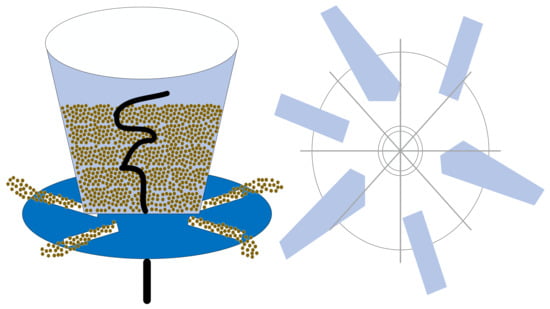 Figure 5. Centrifugal fertilizer ejector.
Figure 5. Centrifugal fertilizer ejector.
- (3)
- When the vibrating fertilizer ejector operates, the rotating fertilizer discharging cam causes the fertilizer discharging vibrating plate to vibrate continuously (Figure 6). Under the dual action of vibration and its own gravity, the fertilizer in the fertilizer box slides along the slope of the vibrating plate and is discharged through the fertilizer discharging port. The vibrating fertilizer ejector is suitable for granular and highly hygroscopic powdery fertilizers. It has a wide application range and simple structure. This fertilizer ejector is mostly used on the mid-tillage fertilizer chaser [101].
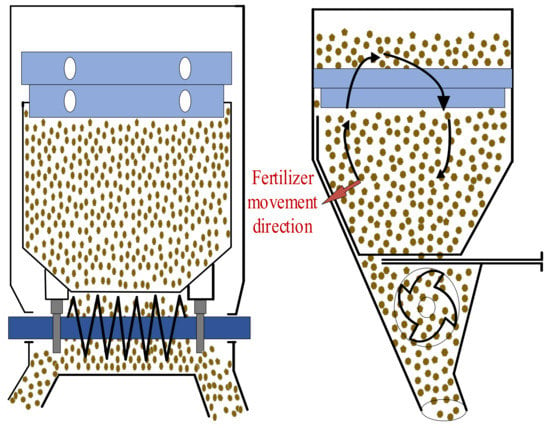 Figure 6. Centrifugal fertilizer ejector.
Figure 6. Centrifugal fertilizer ejector.
- (4)
- The star wheel-type fertilizer extractor is used to apply crystalline and dry powder fertilizers (Figure 7). During the fertilization operation, the rotating star wheel continuously directs fertilizer from the fertilizer tank into the fertilizer pipe. The adjustment of the discharge quantity of the star wheel-type fertilizer exhauster can be realized by adjusting the opening of the discharge valve or changing the speed of the star wheel. Under normal circumstances, the bottom of the fertilizer tank is movable to facilitate the cleaning of excess fertilizer. The star wheel fertilizer exhauster is easy to disassemble and has low troubleshooting difficulty [107].
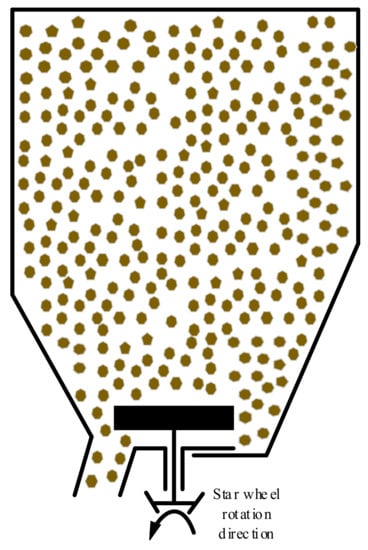 Figure 7. Star wheel fertilizer ejector.
Figure 7. Star wheel fertilizer ejector.
4.1.2. Variable Rate Fertilization Technology Device
- (1)
- Double-variable fertilization device. Univariate fertilization is realized by regulating the rotation speed of the main shaft of the fertilization machine. However, some problems, such as small adjustable range, low fertilization accuracy, and poor uniformity, are encountered when the rotation speed is low. Zhang’s team at Shihezi University proposed a set of double-variable fertilization device and a supporting principle based on the external trough wheel fertilizer ejector. The double-variable fertilization mechanism is shown in Figure 8. Double-variable fertilization is mainly realized by the main shaft hydraulic motor installed at two ends of the main shaft of the fertilizer ejector and the hydraulic motor with opening (the effective working length of the outer groove wheel and the groove wheel of the fertilizer ejector). The double-variable fertilizer applicator with a double adjustment of the spindle speed and fertilizer ejector opening can effectively avoid low fertilization accuracy and poor uniformity of fertilizer applicator operation at a small fertilizer discharge and low spindle speed through a high speed and low opening. At the same time, it can also better avoid the significant effect of the motor pulsation on the fertilization accuracy when the fertilizer with hydraulic motor discharges fertilizer. The double-adjustment structure of the speed opening is shown in Figure 9 [108].
 Figure 8. Structure of variable rate fertilization mechanism. 1: Fertilizer bin; 2: Opening motor; 3: Trenching and earth covering device; 4: Profiling wheel structure; 5: Speed motor; 6: Rack; 7: Fertilizer discharging device.
Figure 8. Structure of variable rate fertilization mechanism. 1: Fertilizer bin; 2: Opening motor; 3: Trenching and earth covering device; 4: Profiling wheel structure; 5: Speed motor; 6: Rack; 7: Fertilizer discharging device. Figure 9. Double regulating mechanism structure of speed and opening. 1: Speed hydraulic motor; 2: Fertilizer discharge box; 3: Fertilizer discharge stop shaft; 4: Opening hydraulic motor.
Figure 9. Double regulating mechanism structure of speed and opening. 1: Speed hydraulic motor; 2: Fertilizer discharge box; 3: Fertilizer discharge stop shaft; 4: Opening hydraulic motor.
- (2)
- Spiral vertebral body centrifugal fertilizer ejector. The smoothness of fertilizer discharge depends on the arching principle of bulk materials above the rectangular discharge port. However, the discharge port easily forms a spherical cavity, which prevents the granular fertilizer from moving down smoothly. Applying external force to the granular fertilizer with spiral blades can effectively prevent its arching and the formation of a cavity. At the same time, the agglomerated fertilizer is disturbed and broken to ensure the smooth downward movement and discharge of the granular fertilizer. To ensure that the granular fertilizer is evenly distributed around the vertebrae, and at the same time, according to the principle of centrifugal seed discharge, the centrifugal fertilizer discharging mode is adopted to ensure the uniformity of the fertilizer entering the fertilizer chamber. A centrifugal push plate at a certain angle with the radial longitudinal section of the fertilizer discharge device is designed to improve the stability of fertilizer discharge capacity and prevent the granular fertilizer from continuously and stably moving to the outer edge under the action of centrifugal force due to insufficient friction. Considering the influence of the traditional fertilizer ejector on the fertilizer discharge performance due to the overhead arching and blockage of fertilizer, Professor Liu of Huazhong Agricultural University analyzed the movement model of granular fertilizer in the fertilizer discharge process of a spiral cone centrifugal fertilizer ejector and the mechanism of disturbance arch breaking and antiblocking. The centrifugal fertilizer ejector with spiral disturbance vertebral body was then designed, as shown in Figure 10, which is mainly composed of an upper shell, a spiral disturbance vertebral disk, and a lower shell [98,99].
 Figure 10. Spirally disturbed vertebral centrifugal fertilizer extractor. 1: Connecting base of fertilizer box; 2: Upper shell; 3: Fertilizer discharge pipe; 4: Spiral disturbance cup; 5: Centrifugal push plate; 6: Fertilizer room; 7: Vertebral disk; 8: Drive shaft; 9: Lower shell; 10: Bearing pedestal.
Figure 10. Spirally disturbed vertebral centrifugal fertilizer extractor. 1: Connecting base of fertilizer box; 2: Upper shell; 3: Fertilizer discharge pipe; 4: Spiral disturbance cup; 5: Centrifugal push plate; 6: Fertilizer room; 7: Vertebral disk; 8: Drive shaft; 9: Lower shell; 10: Bearing pedestal.
4.2. Variable Spraying Technology
Variable spraying technology is a type of equipment that can be developed to irrigate different amounts of water at different locations in accordance with the shape of crops or plots. The sprinkler irrigation machine can be equipped with GPS and GIS. It is the main technical means to realize variable sprinkler irrigation and rational utilization of water resources [109,110].
4.2.1. Principle of Variable Spraying Technology
Variable spraying technology collects detailed crop growth in cultivated land requiring plant protection through visual equipment, sensors, artificial data sampling, and other methods combined with GIS and GPS. A regional grid map with the characteristics of crop disease, insect, and grass is formed by information technology. During operation, plant protection machinery combined with GPS technology performs variable spray operation on crops at different coordinate positions [111,112,113,114,115].
Variable spraying technology can be divided into pressure regulation, variable nozzle regulation, and pulse width modulation (PWM) regulation.
- (1)
- The pressure regulation technology mainly adjusts the servo valve opening size through the control instruction and changes the pressure of each pipeline in the spraying system. The pressure sensor obtains pressure feedback information by adjusting the pressure to change the flow and variable spray results [116,117]. The spray flow rate is proportional to the square root of the pressure difference, which is a nonlinear relationship. Excessive pressure variation affects the nozzle flow rate and has a significant effect on the droplet particle size and droplet distribution. This condition leads to poor spraying results. Therefore, the range of pressure and flow variation in the variable application control process should not be extremely large, usually limited to 25% of the flow variation in engineering applications. Although an inherent nonlinearity is found in pressure-regulated flow, the cost of pressure sensors is lower than that of flow sensors under the same accuracy conditions. Therefore, pressure-regulating flow has potential advantages from an economic standpoint.The regulation characteristics of pressure regulation can be expressed as follows:where is the fluid flow; is the fluid density; and are the fluid pressures at the inlet and outlet of the regulating valve; is the throttling type; is the flow resistance.
- (2)
- Variable nozzle adjustment technology allows you to change the flow rate of the spray nozzle. The control of variable nozzle spraying area is mainly realized by adjusting the nozzle range. When the range of the nozzle changes, the area sprayed by each unit angle of rotation of the nozzle also changes. The rotation speed or flow of the nozzle should be adjusted with the change in range to make the spraying water received on the same area of land the same [118,119,120].For a given sprinkler and sprinkler system, is a constant; is the rotational speed of variable nozzle at time ; is the range of variable nozzle at time ; is the instantaneous flow at time .
- (3)
- PWM is the process where the liquid is mixed in the box in advance; the pipeline pressure is kept constant within a certain flow regulation range, and the nozzle flow is adjusted by controlling the on–off frequency and duty cycle of the nozzle solenoid valve, so as to achieve the effect of variable application. As shown in Figure 11, PWM requires a high response frequency of solenoid valve and needs to respond quickly to the pulse signal. Therefore, a high-frequency solenoid valve is usually used [121,122,123].
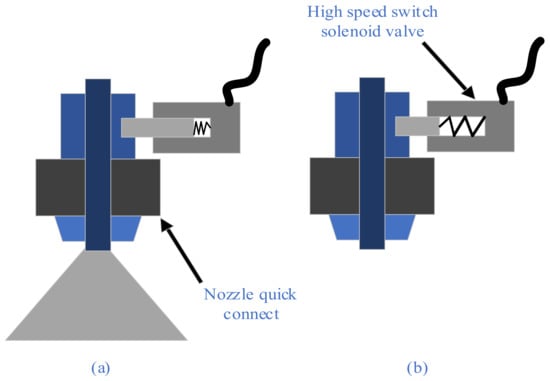 Figure 11. PWM variable nozzle. Solenoid valve on (a); Solenoid valve closed (b).
Figure 11. PWM variable nozzle. Solenoid valve on (a); Solenoid valve closed (b).
4.2.2. Variable Rate Spraying Technology Device
- (1)
- Pressure regulation technology. Gonzalez et al. designed a nonlinear variable spray system based on pressure regulation, as shown in Figure 12. This system measures the pressure in real time by the pressure sensor and controls the injection volume through the electric proportional valve and electric on–off valve. With the opening of the electric proportional valve as the input and the spray pressure measured by the pressure sensor as the output, Gonzalez et al. concluded that the open-loop system can be described by a first-order system and gave the specific formula of the system transfer function as:where the static gain parameter and time parameter of the system are written in the form associated with the system pressure , which reflects the idea of Gonzalez and others to deal with nonlinearity by using the parametric method [124].
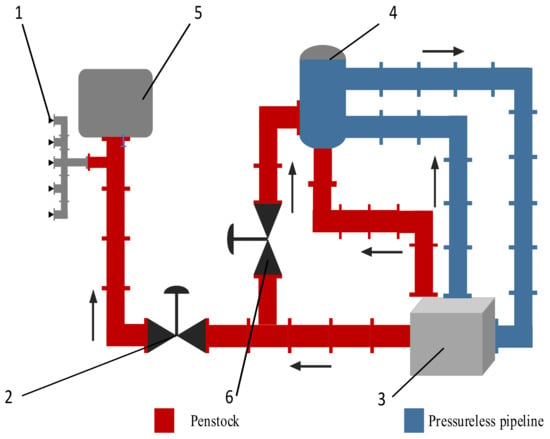 Figure 12. Nonlinear variable spray system. 1: Nozzle; 2: Electric on–off valve; 3: Pump; 4. Medicine box; 5: Pressure sensor; 6: Electric proportional valve. (The black arrow in the figure shows the flow direction of the aqueous solution.)
Figure 12. Nonlinear variable spray system. 1: Nozzle; 2: Electric on–off valve; 3: Pump; 4. Medicine box; 5: Pressure sensor; 6: Electric proportional valve. (The black arrow in the figure shows the flow direction of the aqueous solution.) - (2)
- Variable nozzle adjustment technology. Variable nozzle is relative to the traditional fixed nozzle. “Fixed” denotes that the internal structure of the nozzle is fixed during the working process. To realize variable spraying in crop protection areas, Huang et al. designed an agricultural variable sprinkler based on magnetorheological fluid (Figure 13). The inlet opening of the atomization chamber is controlled without changing the pump pressure to achieve the effect of flow regulation. Magnetorheological fluid is added and controlled at the inlet of the atomization chamber to change its physical state, affect the space of atomization chamber, and realize the required functions [125].
 Figure 13. Three-dimensional cutting view of nozzle. 1: Water inlet; 2: Magnetorheological fluid cavity plug; 3: Coil winding shaft; 4: Magnetorheological fluid chamber; 5: Nozzle end cover; 6: Shell body; 7: Conductor hole; 8: Elastic cavity; 9: Swirl chamber.
Figure 13. Three-dimensional cutting view of nozzle. 1: Water inlet; 2: Magnetorheological fluid cavity plug; 3: Coil winding shaft; 4: Magnetorheological fluid chamber; 5: Nozzle end cover; 6: Shell body; 7: Conductor hole; 8: Elastic cavity; 9: Swirl chamber. - (3)
- PWM. This technology mainly controls electronic actuators by using fast on and off (pulse mode) conversion equipment. The speed of conversion equipment driven by pulse is frequency. Although the PWM intermittent spray flow regulating system has a fast response speed and large flow regulating range, and the use of conventional nozzles can achieve an excellent spraying effect, the requirements for the control system are relatively high. Wang studied the low-altitude variable spraying measurement and control technology of multirotor plant protection UAV and designed a dual nozzle PWM variable spraying measurement and control system. Its spray actuator is shown in Figure 14. The system uses a PWM controller to wirelessly receive the pulse width, operation state, and centrifugal nozzle control signals with adjustable duty ratio. The PWM controller is used to control the working state of the system after data acquisition and drive amplification. The speed of the diaphragm pump and centrifugal nozzle motor can adjust the instantaneous spraying amount of the system [126].
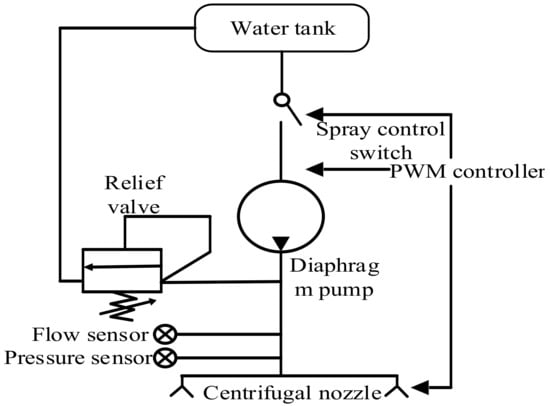 Figure 14. Composition of spray actuator.
Figure 14. Composition of spray actuator.
5. Contribution and Recommendation
5.1. Contribution
Figure 15 shows the key timetable for the development of precision agriculture in relevant countries and the core research objects. After the introduction of precision agriculture technology in 1960, many modern scientific and technological elements were derived. These elements can be divided into three key stages. The first stage is agricultural information collection technology; the second is information processing and decision-making technology, and the third is information execution technology. Each of them is proposed to ensure the quality and quantity of crops [127,128,129,130,131]. A large number of documents have been published and widely studied with the proposal of precision agriculture technology. However, bibliometric analysis is an effective tool for the quantitative analysis of scientific publications, research trends, hotspots, and cooperation relationships to comprehensively understand the current situation and future trend of precision agriculture. The published articles were searched by SCI-E on 10 April 2022 and analyzed by CiteSpace and bibliometrics. The search method was a keyword search, and the content was “precision agriculture”. Figure 16 shows the annual number and trend of documents issued in precision agriculture from 2008 to 2021. The attention in this field has increased since 2008. In particular, the annual number of documents issued in this field has increased significantly since 2016 and exceeded 100 in 2017. China, Brazil, and the United States are the main contributors to the number of documents published in this field. As the world’s most advanced scientific and technological power, the United States has always been in the forefront of research on advanced technology. In recent years, the number of documents issued by China and Brazil has increased, and they have been the main contributors in this field. In particular, the number of documents issued by China in this field has shown a straight-line upward trend since 2018, which reflects China’s attention to agricultural green, environmental protection, and low-carbon transformation.
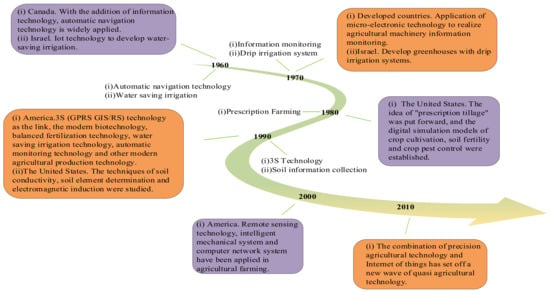
Figure 15.
Time and derivation of precision agriculture development.
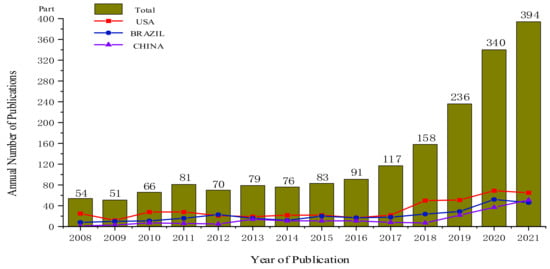
Figure 16.
Annual number of documents issued and the trend of documents issued in accordance with the search formula: “precision agriculture”.
5.1.1. Contribution of Leading Countries
Researchers from 99 countries and regions have conducted detailed and extensive research in this field from 2008 to 2022 through the quantitative analysis of the academic literature published in the field of precision agriculture. Figure 17 shows the top 10 most productive countries/regions. Among them, the literature published by the United States ranks first in the world (about 25.5%), followed by Brazil (about 17.3%), and China ranks third (about 11.3%), and Spain (about 11%) and Italy (about 8.8%) rank fourth and fifth, respectively. Figure 18 shows the cooperation relationship of the top 20 most productive countries/regions. The larger the circle, the more cited; the thicker the connecting line, the more cooperation, and the darker the color, the older the year. The number of citations in American literature is the highest.
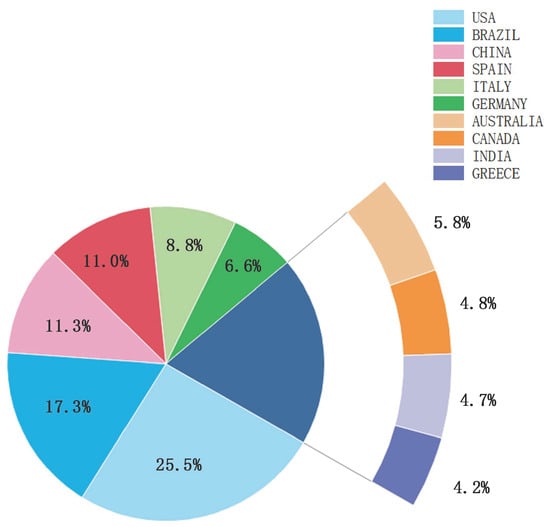
Figure 17.
Contribution and influence of top 10 countries/regions in the field of precision agriculture.
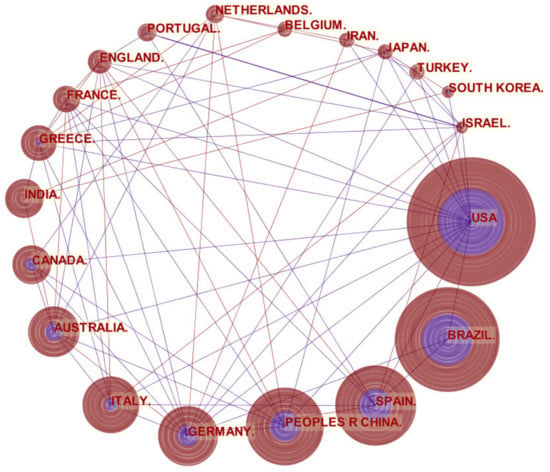
Figure 18.
Cooperation matrix of the top 20 countries/regions with the highest productivity (circle size represents the number of citations).
5.1.2. Contribution of Leading Institutions
Figure 19 shows that more detailed and specific information can be achieved by scholars through the statistical analysis of research institutions. Among the top 40 most productive research institutions, most of them are from the top 10 countries. The University of Florida ranks first with 19 articles, followed by the agricultural organization of the U.S. Department of Research and the University of Sao Paulo in Brazil. In terms of TC (total citations), the University of Florida ranked first (19), followed by the agricultural organization of the United States Department of Research (17) and the University of Sao Paulo in Brazil (15). The cooperative relationship among organizations can send a message of cooperation intention to researchers, so as to help scholars cooperate more. Figure 19 shows the cooperation relationship among the institutions with 5 or more papers among the top 100 highly cited papers from 2008 to 2022, where the larger circle size represents the more cited papers, and the thicker connecting line represents the more cooperation between the two. From the figure, cooperation has become the choice of various institutions, and most institutions have more or less cooperative relations.
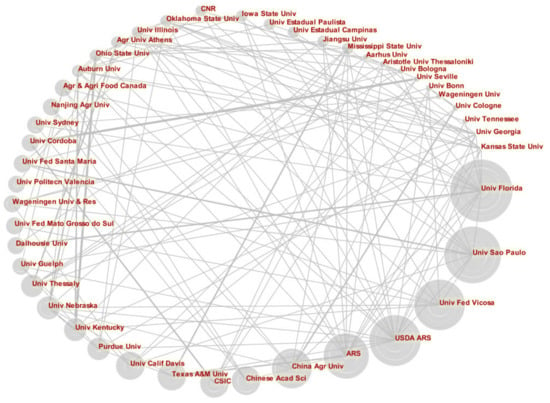
Figure 19.
Figure cooperation relationship of institutions with five or more documents.
5.1.3. Contribution of Leading Corresponding Authors
As shown in Figure 20, the academic contribution of precision agriculture comes from different research teams, and that the research team is scattered by analyzing the relationship between the author and cocitation. The size of the text in the figure represents the influence of the work. Molin JP, Teodoro PE, and Osco LP are the extremely active representative researchers in this field. These active teams and authors also focus on greater contributions. Molin JP and others are mainly interested in GPS and sensor technology of information acquisition technology in precision agriculture. Teodoro PE and Osco LP are mainly interested in UAV and remote sensing vegetation spectrum prediction.
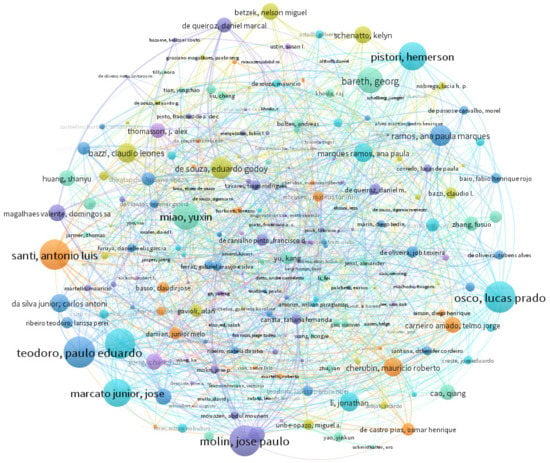
Figure 20.
Author influence analysis.
5.1.4. Leading Journals in Terms of the Number of Publications
In accordance with statistics, 219 publishers published 2001 articles related to this field, where the top 10 journals are shown in Table 5. The top 10 journals published 873 articles, accounting for 43.6% of the total number, where Computers and Electronics in Agriculture published the most, with a total of 246 articles, and Remote Sensing (132) and Sensors (124) ranked second and third, respectively, and Agriculture Basel (77) ranked fourth. In terms of acpp, IEEE access ranked first with an average of 23.47 citations per article, and Precision Agriculture (8.68) and Transactions of the ASABE (8.27) ranked second and third, respectively.

Table 5.
Journal impact analysis.
5.1.5. Leading Institutions in Terms of the Number of Publications
In accordance with statistics, 196 publishers published articles related to this field, where the top 20 are shown in Table 6. The top 20 journals published 887 articles, accounting for 44.3% of the total, where the United States Department of Agriculture published the most, with a total of 104 articles. Universidade de Sao Paulo (72) and Consejo Superior de Investigaciones Cientificas (64) ranked second and third, respectively, and the State University System of Florida (56) ranked fourth. In terms of acpp, the University of California System ranked first with an average of 38.82 citations per article, and China Agricultural University (38.78) and Wageningen University Research (33.90) ranked second and third, respectively. The top 20 institutions from the USA account for 45%.

Table 6.
Mechanism impact analysis.
5.1.6. Patent Status for Precision Agriculture
The number of patent applications can reflect the application prospect of this technology to a certain extent. A total of 531 invention patent applications are found worldwide, and the number of applications in recent years is relatively large after searching the number of invention patent applications related to precision agriculture around the world, as shown in Figure 21. However, the recent decline in the number of patent applications for invention related to precision agriculture may be related to the current application of the technology, which indicates that the existing technical scheme is transitioning to a mature stage. The relevant patents are listed in Figure 22. The relevant invention patent applications are concentrated in China.
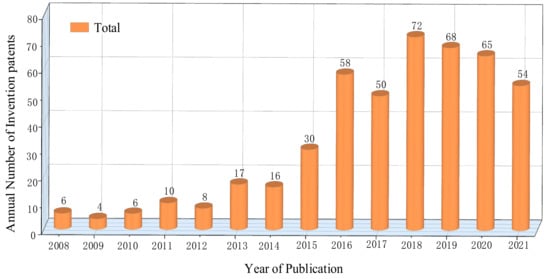
Figure 21.
Number of patent applications for inventions related to precision agriculture in the last 14 years.

Figure 22.
Contribution and influence of top 10 countries/regions in the number of patents in precision agriculture. CN: China; US: United States; WO: World Intellectual Property Organization; EP: Europe; AU: Australia; CA: Canada; GB: Great Britain; JP: Japan; ES: Spain; RU: Russia.
5.2. Recommendation—Intelligent Agriculture
Data collection and sorting are essential in precision agriculture and require the intervention of big data. Therefore, this study arranges the first five highly cited papers [132,133,134,135,136] by searching the keywords of Web of Science database for readers (Table 7). The retrieval formula is: “intelligent agriculture.”

Table 7.
Impact analysis of relevant literature.
6. Conclusions and Prospects
6.1. Conclusions
The three basic steps of realizing precision fertilization and irrigation are analyzed, and the conclusions can be summarized as follows: (1) GPS, remote sensing, and wireless sensor technologies are used in the information collection system to realize crop information collection, which can effectively realize field information collection. (2) The information management and decision-making system can manage and summarize the information in crop growth. At the same time, it organically combines the knowledge of various disciplines and expert knowledge and applies it to specific crops. (3) The execution system can accurately realize the fertilizer and water required by crops. With variable rate fertilization, the accuracy of fertilizer use is the key factor, and the stability of variable rate equipment is the primary factor. In variable rate spraying, pressure-regulating technology and variable rate nozzle in variable rate spray technology still occupy the mainstream of the market due to their relatively low cost. The development of new technologies is extremely important to improve the performance of low-cost devices. The feedback speed of the sensor and the response speed of the controller are insufficient at this stage. The response time is extremely long, which prevents the flow to be accurately adjusted for target pests and weeds. Therefore, sensitivity is an important factor restricting the development of variable spray technology. Improving the sensitivity of parts and reducing the response time are imperative. New algorithms and new software must be developed to accelerate the speed of information processing.
6.2. Prospects
Research on precision fertilization and irrigation should be strengthened in several aspects to improve its development level: (1) Agriculture is developing from the traditional extensive type to the refined type. How to combine the actual characteristics of farmland, utilization of network technology, and the development of a real-time monitoring system of farm machinery based on GPS and sensor technology are the key factors to improve traditional agriculture. The analysis of geographic information data can effectively handle all farming types, improve the efficiency of mechanical operation, and provide technical support for the further realization of variable farming and is a track for further improvements. (2) On the basis of introducing and processing foreign advanced technology, the development of a professional precision fertilization and irrigation monitoring system with independent intellectual property rights should be prioritized. Low-cost technological achievements and supporting key technology and equipment of precision fertilization and irrigation are urgent problems to be solved in China’s implementation of precision fertilization and irrigation. (3) A national unified agricultural data center and information platform should be created. The government, enterprises, and research parties should work together to integrate multiple fragmented agricultural information platforms and databases and build a national agricultural cloud platform with all data in one and a corresponding data sharing and coconstruction mechanism with the help of cloud, network security, and data-intensive computing technologies. Farmers will have access to all basic services (subsidies, credit, insurance, government services, market, and farming information) under one roof. The platform will address the needs of smallholder farmers throughout the agricultural cycle—from farm preparation, farm inputs, harvest, and postharvest activities—by integrating agricultural stakeholders at the national level. (4) Research of technology integration should be strengthened, and the compatibility, standardization, and common interface among various technologies should be explored, and the effective connection between diversified technologies should be realized. Deep integration and integration of agricultural equipment with remote sensing technology, positioning system, intelligent decision making, wireless sensor network technology, electronic control, and other technologies are regarded as the fundamental elements of the future of precision fertilization and irrigation.
Author Contributions
Y.L. was the main author of the review and completed the collection and analysis of relevant literature and the writing of the first draft of the paper. M.L., X.L. (Xiaochu Liu), C.C., X.L. (Xinping Li), and Z.K. participated in the analysis and collation of literature materials. C.L. is the author and principal of the project and supervised the writing of the thesis. All authors have read and agreed to the published version of the manuscript.
Funding
This study was funded by the Youth Science Foundation (52105264) and the Special Project of Qingdao Science and Technology Demonstration and Guidance for Benefiting People (21-1-4-NY-20-NSH).
Institutional Review Board Statement
Not applicable.
Informed Consent Statement
Not applicable.
Data Availability Statement
Not applicable.
Conflicts of Interest
The authors declare no conflict of interest.
References
- Geng, X. Farmland Grid Division and Its Application in Precision Agriculture from Multiple Perspectives. Shandong Agric. Univ. China 2020. [Google Scholar] [CrossRef]
- Wang, F.; Zang, S. Research Progress of the Farming Information Collections Key Technologies on Precision Agriculture. Trans. Chin. Soc. Agric. Mach. 2008, 5, 112–121. [Google Scholar]
- Wen, Y.; Wang, S. Application and Research of Gis Technology in Precision Agriculture Model. Jinwei Heaven Earth 2020, 5, 73–75. [Google Scholar] [CrossRef]
- Zhao, W.; Yang, S.; Yang, Q.; Yang, S. The Development and Thinking of the Precision Agriculture Technology. Agric. Mech. Res. 2007, 4, 67–170. [Google Scholar] [CrossRef]
- Liu, Y. The Agro-ecological Environment Protection Mechanisms and Countermeasures to Food Security. Agric. Mech. Res. 2012, 34, 232–235+240. [Google Scholar] [CrossRef]
- Li, H.; Li, Y.; Li, R. Research Progress on the Effect of lrrigation and Nitrogen Application on Wheat Yield Formation and Soil Fertility. J. Wheat Crops 2022, 2, 1–15. [Google Scholar] [CrossRef]
- Wang, Y.; Peng, Z.; Xue, S.; Yang, Y.; Zhou, Y.; Zhao, L. Effect of Excessive Fertilization on Soil Ecological Environment in the Facility Farmland. J. Agro-Environ. Sci. 2005, S1, 81–84. [Google Scholar] [CrossRef]
- Zhao, Y.; Huang, N.; Liu, J.; Zhou, J.; Li, S.; Li, Y. Effects of Optimized Fertilization on the Yield, Quality and Soil Available Nutrients of Greenhouse Lettuce in Suburban Areas of Beijing. Chin. Veg. 2019, 32, 42–44, 53. [Google Scholar] [CrossRef]
- Chen, J.; Wang, Y.; Li, H.; Wang, L.; Qiu, J.; Xiao, B. Characteristics Soil Nitrate Nitrogen Distribution, accumulation and Nitrogen Balance in Winter Wheat Field Under Drip Fertigationl. J. Plant Nutr. Fertil. 2015, 21, 927–935. [Google Scholar]
- Miller, K.A.; Luck, J.D.; Heeren, D.M.; Lo, T.; Martin, D.L.; Barker, J.B. A Geospatial Variable Rate Irrigation Control Scenario Evaluation Methodology Based on Mining Root Zone Available Water Capacity. Precis. Agric. 2018, 19, 666–683. [Google Scholar] [CrossRef] [Green Version]
- Zhang, M. Information Collection of the Plant Biological Characteristic parameters and Growth Environment of Agriculture and Forestry; China Agricultural University: Beijing, China, 2016. [Google Scholar]
- Duan, A.; Meng, Z. Present Situation of Techniques and Equipments of Monitoring Crop Water Status. China Agric. Sci. Technol. Her. 2007, 1, 6–14. [Google Scholar] [CrossRef]
- Tian, H.; Wang, T.; Liu, Y.; Qiao, X.; Li, Y. Computer Vision Technology in Agricultural Automation—A Review. Inf. Process. Agric. 2020, 1, 1–19. [Google Scholar] [CrossRef]
- Liu, M.; Li, C.; Cao, C.; Li, X.; Che, J.; Zhao, H. Research Status of Key Technologies and Devices for Walnut By-products Processing. J. Chin. Agric. Mech. 2021, 42, 55–74. [Google Scholar] [CrossRef]
- Song, Y.; Liu, B.; Wei, X.; Ba, C.; Heng, J. Application Progress of Wireless Sensor Technology in Precision Agriculture in Era of Big Data. Jiangsu Agric. Sci. 2021, 49, 31–37. [Google Scholar] [CrossRef]
- Mahan, J.R.; Lascano, R.J. Irrigation Analysis Based on Long-term Weather Data. Agriculture 2016, 6, 42. [Google Scholar] [CrossRef] [Green Version]
- Wang, X.; Wen, H.; Li, X.; Fu, Z.; Lu, X.; Zhang, L. Research Progress Analysis of Mainly Agricultural Diseases Detection and Early Warning Technologies. Trans. Chin. Soc. Agric. Mach. 2016, 47, 266–277. [Google Scholar] [CrossRef]
- He, D.; He, Y.; Li, M.; Hong, T.; Wang, C.; Song, S.; Liu, Y. Research Progress of Information Science-related Problems in Precision Agriculture. China Sci. Found. 2011, 25, 10–16. [Google Scholar] [CrossRef]
- Mahan, J.R.; Payton, P.R.; Laza, H.E. Seasonal Canopy Temperatures for Normal and Okra Leaf Cotton Under Variable Irrigation in the Field. Agriculture 2016, 6, 58. [Google Scholar] [CrossRef] [Green Version]
- Liu, M.; Li, C.; Cao, C.; Tuerdi, T.L.H.; Li, X.; Che, J.; Yang, H.; Zhang, X.; Shi, M.; Zhao, H.; et al. Research Progress of Key Technology and Device for Size-grading Shell-breaking and Shell-kernel Separation of Walnut. Trans. Chin. Soc. Agric. Eng. 2020, 36, 294–310. [Google Scholar] [CrossRef]
- Ma, X.; Zhang, Z.; Gao, D.; Li, M.; Sun, H.; Li, S. Design of Crop lnformation Storage Analysis System Based on Cloud Service Architecture. Trans. Chin. Soc. Agric. Mach. 2019, 50, 122–127. [Google Scholar] [CrossRef]
- Li, D.; Yang, H. State-of-the-art Review for Internet of Things in Agriculture. Trans. Chin. Soc. Agric. Mach. 2018, 49, 1–20. [Google Scholar] [CrossRef]
- Zhu, Y.; Chen, S.; Wang, X. Development and Application in Precision Agriculture of GIS. Agric. Mech. Res. 2007, 5, 179–180. [Google Scholar] [CrossRef]
- Liu, G.; Wu, M.; Niu, Z.; Wang, C. Lnvestigation Method for Crop Area Using Remote Sensing Sampling Based on Gf-1 Satellite Data. Trans. Chin. Soc. Agric. Eng. 2015, 31, 160–166. [Google Scholar] [CrossRef]
- Song, Y. Agricultural Information Technology and the Development of Precision Agriculture. Agric. Eng. Technol. 2020, 40, 53–54. [Google Scholar] [CrossRef]
- Zhang, D.; Pan, F.; Diao, Q.; Feng, X.; Li, W.; Wang, J. Seeding Crop Detection Framework Using Prototypical Network Method in Uav Images. Agricultural 2021, 12, 26. [Google Scholar] [CrossRef]
- Wang, P.; Luo, X.; Zhou, Z.; Zang, Y.; Hu, L. Key Technology for Remote Sensing Information Acquisition Based on Micro UAV. Trans. Chin. Soc. Agric. Eng. 2014, 30, 1–12. [Google Scholar] [CrossRef]
- Niu, Q.; Feng, H.; Yang, G.; Li, C.; Yang, H.; Xu, B.; Zhao, Y. Monitoring Plant Height and Leaf Area Index of Maize Breeding Material Based on UAV Digital Images. Trans. Chin. Soc. Agric. Eng. 2018, 34, 73–82. [Google Scholar] [CrossRef]
- Zhang, Z.; Wang, H.; Han, W.; Bian, J.; Chen, S.; Cui, T. Inversion of Soil Moisture Content Based on Multispectral Remote Sensing of UAVs. Trans. Chin. Soc. Agric. Mach. 2018, 49, 173–181. [Google Scholar] [CrossRef]
- Yang, W.; Li, C.; Yang, H.; Yang, G.; Feng, H.; Han, L.; Niu, Q.; Han, D. Monitoring of Canopy Temperature of Maize Based on Uav Thermal Infrared Imagery and Digital Imagery. Trans. Chin. Soc. Agric. Eng. 2018, 34, 68–75. [Google Scholar] [CrossRef]
- Jia, Y.; Li, Y. Application of Remote Sensing Technology in Agriculture. South. Agric. 2020, 14, 179+188. [Google Scholar] [CrossRef]
- Khanal, S.; Fulton, J.; Shearer, S. An Overview of Current and Potential Applications of Thermal Remote Sensing in Precision Agriculture. Comput. Electron. Agric. 2017, 139, 22–32. [Google Scholar] [CrossRef]
- Liu, H. Application of Remote Sensing Technology in Modern Agricultural Engineering. Agric. Eng. Technol. 2020, 40, 49–50. [Google Scholar] [CrossRef]
- Wu, K. Development Direction of Crop Pest Control Science and Technology in China. J. Agron. 2018, 8, 35–38. [Google Scholar]
- Zhang, S.; Zhang, C.; Ding, J. Disease and Insect Pest Forecasting Model of Greenhouse Winter Jujube Based on Modified Deep Belief Network. Trans. Chin. Soc. Agric. Eng. 2017, 33, 202–208. [Google Scholar] [CrossRef]
- Lu, Y.; He, X.; Lu, H.; Li, P. Development status and prospect of precision agriculture in China. Agric. Equip. Technol. 2004, 3, 8–10. [Google Scholar] [CrossRef]
- Zhang, T.; Gong, B.; Liu, Y. Design and Application of Remote Control System of Protected Vegetable Environment Based on the Internet of Things. J. Agric. Univ. Hebei 2016, 39, 119–125. [Google Scholar] [CrossRef]
- Zhao, C.; Xue, X.; Wang, X.; Chen, L.; Pan, Y.; Meng, Z. Advance and Prospects of Precision Agriculture Technology System. Trans. Chin. Soc. Agric. Eng. 2003, 4, 7–12. [Google Scholar] [CrossRef]
- Zhang, X.; Wang, Y.; Fang, X.; Zhao, H. Information Acquisition Techniques of Precision Agriculture. Trans. Chin. Soc. Agric. Mach. 2002, 6, 125–128. [Google Scholar] [CrossRef]
- Geipel, J.; Link, J.; Wirwahn, J.A.; Claupein, W. A Programmable Aerial Multispectral Camera System for In-season Crop Biomass and Nitrogen Content Estimation. Agriculture 2016, 6, 4. [Google Scholar] [CrossRef] [Green Version]
- Zhou, J. Analysis and Prospect of Precision Agriculture Technology System. South. Farm Mach. 2021, 52, 8–11, 14. [Google Scholar] [CrossRef]
- Wu, S.; Ren, J.; Liu, J.; Li, D. Multispectral lmages Sub-pixel Mapping in Agricultural Region. Trans. Chin. Soc. Agric. Mach. 2015, 46, 311–320. [Google Scholar] [CrossRef]
- Rice, D.C.; Carriveau, R.; Ting, D.S.K.; Bata, M.T.H. Evaluation of Crop to Crop Water Demand Forecasting: Tomatoes and Bell Peppers Grown in a Commercial Greenhouse. Agriculture 2017, 7, 104. [Google Scholar] [CrossRef] [Green Version]
- Bu, X.; Guo, H.; Huang, K. Performance and Application of Thermal Infrared Remote Sensing in Farmland Environmental Water Monitoring. Jiangsu Agric. Sci. 2020, 48, 25–30. [Google Scholar] [CrossRef]
- Ma, H.; Huang, W.; Jing, Y. Wheat Powdery Mildew Forecasting in Filling Stage Based on Remote Sensing and Meteorological Data. Trans. Chin. Soc. Agric. Eng. 2016, 32, 165–172. [Google Scholar]
- Abdulridha, J.; Ehsani, R.; De Castro, A. Detection and Differentiation Between Laurel Wilt Disease, Phytophthora Disease, and Salinity Damage Using a Hyperspectral Sensing Technique. Agriculture 2016, 6, 56. [Google Scholar] [CrossRef] [Green Version]
- Cozzolino, D.; Porker, K.; Laws, M. An Overview on the Use of Infrared Sensors for in Field, Proximal and at Harvest Monitoring of Cereal Crops. Agriculture 2015, 5, 713–722. [Google Scholar] [CrossRef] [Green Version]
- Xiao, K.; Xiao, D.; Luo, X. Smart Water-saving Irrigation System in Precision Agriculture Based on Wireless Sensor Network. Trans. Chin. Soc. Agric. Eng. 2010, 26, 170–175. [Google Scholar] [CrossRef]
- Higgins, S.; Schellberg, J.; Bailey, J.S. Improving Productivity and Increasing the Efficiency of Soil Nutrient Management on Grassland Farms in the UK and Ireland Using Precision Agriculture Technology. Eur. J. Agron. 2019, 106, 67–74. [Google Scholar] [CrossRef]
- Lakhankar, T.; Ghedira, H.; Temimi, M.; Sengupta, M.; Khanbilvardi, R.; Blake, R. Non-parametric Methods for Soil Moisture Retrieval from Satellite Remote Sensing Data. Remote Sens. 2009, 1, 3–21. [Google Scholar] [CrossRef] [Green Version]
- Gaikwad, P.; Devendrachari, M.C.; Thimmappa, R.; Paswan, B.; Raja Kottaichamy, A.; Makri Nimbegondi Kotresh, H.; Thotiyl, M.O. Galvanic Cell Type Sensor for Soil Moisture Analysis. Anal. Chem. 2015, 87, 7439–7445. [Google Scholar] [CrossRef]
- Boursianis, A.D.; Papadopoulou, M.S.; Diamantoulakis, P.; Liopa-Tsakalidi, A.; Barouchas, P.; Salahas, G.; Karagiannidis, G.; Wan, S.; Goudos, S.K. Internet of Things (IOT) and Agricultural Unmanned Aerial Vehicles (UAVs) in Smart Farming: A Comprehensive Review. Internet Things 2022, 18, 100187. [Google Scholar] [CrossRef]
- Smolka, M.; Puchberger-Enengl, D.; Bipoun, M.; Klasa, A.; Kiczkajlo, M.; Śmiechowski, W.; Sowiński, P.; Krutzler, C.; Keplinger, F.; Vellekoop, M.J. A Mobile Lab-on-a-chip Device for On-site Soil Nutrient Analysis. Precis. Agric. 2017, 18, 152–168. [Google Scholar] [CrossRef]
- Monteiro, A.; Santos, S.; Gonçalves, P. Precision Agriculture for Crop and Livestock Farming—brief Review. Animals 2021, 11, 2345. [Google Scholar] [CrossRef]
- Matthews, A. The Contribution of Research to Agricultural Policy in Europe. Bio-Based Appl. Econ. 2021, 10, 185–205. [Google Scholar] [CrossRef]
- Sun, H.; Zhang, X.; Yu, Z.; Xi, G. Feature Recognition of Crop Growth Information in Precision Farming. Complexity 2018, 2018, 9250832. [Google Scholar] [CrossRef]
- Yao, L.; Wu, R.; Wu, S.; Jiang, X.; Zhu, Y.; Cao, W.; Ni, J. Design and Testing of an Active Light Source Apparatus for Crop Growth Monitoring and Diagnosis. IEEE Access 2020, 8, 206474–206490. [Google Scholar] [CrossRef]
- Wang, Y.; Peng, D.; Yu, L.E.; Zhang, Y.; Yin, J.; Zhou, L.; Zheng, S.; Wang, F.; Li, C. Monitoring Crop Growth During the Period of the Rapid Spread of COVID-19 in China by Remote Sensing. IEEE J. Sel. Top. Appl. Earth Obs. Remote Sens. 2020, 13, 6195–6205. [Google Scholar] [CrossRef]
- Qiao, X.; Li, C.; Wang, C. The System of Collection and Disposing Based on Image Disposing Technologyfor Crop Information in Greenhouse. J. Huazhong Agric. Univ. 2004, A2, 74–77. [Google Scholar] [CrossRef]
- Zhu, J.; Li, R.; Dong, W.; Zhang, L.; Fang, Y.; Zhang, M. Design of Farmland Microclimate Monitoring System for Disease Pest and Weed Based on Data Preprocessing. Mod. Agric. Technol. 2017, 15, 277–279. [Google Scholar] [CrossRef]
- Dong, Y.; Xu, F.; Liu, L.; Du, X.; Ren, B.; Guo, A.; Geng, Y.; Ruan, C.; Ye, H.; Huang, W.; et al. Automatic System for Crop Pest and Disease Dynamic Monitoring and Early Forecasting. IEEE J. Sel. Top. Appl. Earth Obs. Remote Sens. 2020, 13, 4410–4418. [Google Scholar] [CrossRef]
- Zeng, J.; Lu, Y.; Liu, M.; Jian, G.; Li, X.; Jiang, Y.; Liu, J.; Zhao, Y.; Liu, S. Development and Implementation of an Intelligent Decision Support System for Diagnosis and Management of Cotton Pests. China Plant Prot. Guide 2017, 37, 30–36. [Google Scholar] [CrossRef]
- Yong, M.; Zhang, M.; Wang, S.; Liu, G. A Flex and ArcGIS Server Based System for Farmland Environmental Quality Assessment and Prediction in an Agricultural Producing Area. Comput. Electron. Agric. 2015, 112, 193–199. [Google Scholar] [CrossRef]
- Ming, D. Research on Information Acquisition and Processing System of Farmland Based on GPS. Anhui Agric. Sci. 2010, 38, 2175–2177. [Google Scholar] [CrossRef]
- Tan, H.; Pan, X. Development of Farmland Information Collection System Based on Embedded Electronic Information. Agric. Mech. Res. 2019, 41, 238–241. [Google Scholar] [CrossRef]
- Min, L.; Li, L. lnformation Fast Acquisition System for Farmland Environment Based on RTU. Agric. Netw. Inf. 2012, 12, 19–23. [Google Scholar] [CrossRef]
- Huang, Y. Design of Rice Soil Nutrient Detection System Based on GPS Technology. Agric. Mech. Res. 2021, 43, 99–102, 131. [Google Scholar] [CrossRef]
- Zhou, G.; Zhou, J.; Miao, Y.; Liu, C. Development and Application on GSM-based Monitoring System for Digital Agriculture. Trans. Chin. Soc. Agric. Eng. 2005, 6, 87–91. [Google Scholar] [CrossRef]
- Wu, D. Design and Application of High Precision Positioning System for Hybrid Agricultural Plant Protection UAV Based on GPS and GPRS. Agric. Eng. 2018, 8, 37–40. [Google Scholar] [CrossRef]
- Ma, J.; Zhang, X. Study on Remote Sensing Fieldhy Perspectral Characteristics of Lycium Barbarum Diseases and Pests. Guangdong Agric. Sci. 2015, 42, 165–172. [Google Scholar] [CrossRef]
- Li, W.; Shen, S.; He, P.; Hao, D.; Fang, Y.; Tao, L.; Zhang, S. Low Cost Small Uav Remote Sensing Method for Locating Dead and Diseased Trees. Dev. For. Sci. Technol. 2014, 28, 102–106. [Google Scholar] [CrossRef]
- Yuan, L.; Zhang, H.; Zhang, Y.; Xing, C.; Bao, Z. Feasibility Assessment of Multi-spectral Satellite Sensors in Monitoring and Discriminating Wheat Diseases and Insects. Optik 2017, 131, 598–608. [Google Scholar] [CrossRef]
- Liu, X.D.; Sun, Q.H. Early Assessment of the Yield Loss in Rice Due to the Brown Plant—Hopper Using a Hyper—Spectral Remote Sensing Method. Int. J. Pest Manag. 2016, 62, 205–213. [Google Scholar] [CrossRef]
- Wang, Z. The Detection of Trunk Borer Damage for Platycladus Orientalis Plants Based on Gas Sensor Technology; Zhejiang University: Hangzhou, China, 2020. [Google Scholar] [CrossRef]
- Rui, J. Magnetic Resonance Sensor for Soil Moisture Measurement; Chongqing University: Chongqing, China, 2020. [Google Scholar] [CrossRef]
- Liu, H.; Xu, H.; Shen, Y.; Li, N. Measurement and 3D-reconstruction of Plants Based on Kinect Sensor. Study Agric. Mod. 2016, 37, 995–1000. [Google Scholar] [CrossRef]
- Liu, M.; Li, C.; Cao, C.; Wang, L.; Li, X.; Che, J.; Yang, H.; Zhang, X.; Zhao, H.; He, G.; et al. Walnut Fruit Processing Equipment: Academic Insights and Perspectives. Food Eng. Rev. 2021, 13, 822–857. [Google Scholar] [CrossRef]
- Lin, Y.; Cai, F.; Li, Z. China’s Miracle: Development Strategy and Economic Reform (updated Edition). Qinghai Party Life 2017, 8, 59. [Google Scholar]
- Lu, Y.; Zhong, Y. The Greyzone and Control of Soybean Optima Heading Period a System Control Informa Tion Methodologies & Application. Wuhan Huazhong Univ. Sci. Technol. Press 1994, 1, 168–1171. [Google Scholar]
- Feng, L.; Sun, G.; Mao, S.; Lim, Y.; Han, Y.; Wang, G.; Dong, C.; Zhu, Q. Digital Information Management Decision System for Cotton Production and Growth Based on Farmers. China’s Cotton 2011, 38, 19–24. [Google Scholar] [CrossRef]
- Li, J.; Guo, M.; Gao, L. Application and innovation strategy of agricultural lnternet of Things. Trans. Chin. Soc. Agric. Eng. 2015, 31, 200–209. [Google Scholar]
- Shi, M.; Liu, M.; Li, C.; Cao, C.; Li, X. Design and Experiment of Cam Rocker Bidirectional Extrusion Walnut Shell Breaking Deviice. Trans. Chin. Soc. Agric. Mach. 2022, 1, 140–150. [Google Scholar] [CrossRef]
- Dong, S.; Yuan, C.; Gu, C.; Yang, F. Research on Intelligent Agricultural Machinery Control Platform Based on Multi-discipline Technology Integration. Trans. Chin. Soc. Agric. Eng. 2017, 33, 1–11. [Google Scholar] [CrossRef]
- Qi, G.; Zhou, B.; Niu, Z. A Simulation, Optimization, Decision and Consultation System of Soybean Cultivating Based on ES. Trans. Chin. Soc. Agric. Mach. 2005, 9, 93–96. [Google Scholar] [CrossRef]
- Wang, H.; Lu, X. Cotton Fertilization Expert System Using GIS Technology in Xinjiang Region. Xinjiang Agric. Sci. 2008, S2, 51–56. [Google Scholar] [CrossRef]
- Chen, L.; Zhao, C.; Liu, X.; Du, X. Design and lmplementation of Intelligent Decision Support System for Precision Agriculture. Trans. Chin. Soc. Agric. Eng. 2002, 2, 145–148. [Google Scholar] [CrossRef]
- Liu, X.; Zhu, Y.; Yao, X.; Tian, Y.; Cao, W. WebGIS-based System for Agricultural Spatial Information Management and Aided Decision-making. Trans. Chin. Soc. Agric. Eng. 2006, 5, 125–129. [Google Scholar] [CrossRef]
- Cao, L.; Wang, C.; Zhang, Y.; Li, B.; Du, W.; Feng, G.; Zhang, Z.; Li, B. Design and Implementation of Decision-making System for Tobacco Precision Fertilization in Panzhihua Tobacco Growing Area Based on RIA Web GIS. Acta Tab. Sin. 2015, 21, 94–99. [Google Scholar] [CrossRef]
- Sawyer, J.E. Concepts of Variable Rate Technology with Considerations for Fertilizer Application. J. Prod. Agric. 1994, 7, 195–201. [Google Scholar] [CrossRef]
- Jin, H.; He, J.; Qian, Y. Application of VRT in Precision lrrigation. Water Sav. Irrig. 2003, 1, 46. [Google Scholar] [CrossRef]
- Han, W. Variable Rate Watering and Contour Controlled Precision Sprinkler and Sprinkler Irrigation; Northwest A&F University: Xianyang, China, 2003. [Google Scholar]
- Hu, Z.; Tian, L.; Peng, B.; Wu, F.; Wang, H. The Application of Variable Rate Technology on Agricultural Machines. Agric. Mech. Res. 2009, 31, 226–229. [Google Scholar] [CrossRef]
- Zhou, H.; Ma, X.; Yao, Y. Research Advances and Prospects in the Seeding Technology and Equipment for Tray Nursing Seedlings of Rice. Trans. Chin. Soc. Agric. Eng. 2008, 4, 301–306. [Google Scholar] [CrossRef]
- Chen, X.; Luo, X.; Wang, Z.; Zhang, M.; Hu, L.; Zeng, S.; Mo, Z. Experiment of Synchronous Side Deep Fertilizing Technique with Rice Hilldrop Drilling. Trans. Chin. Soc. Agric. Eng. 2014, 30, 1–7. [Google Scholar] [CrossRef]
- Tang, H.; Wang, J.; Xu, C.; Zhou, W.; Wang, J.; Wang, X. Research Progress Analysis on Key Technology of Chemical Fertilizer Reduction and Efficiency Increase. Trans. Chin. Soc. Agric. Mach. 2019, 50, 1–19. [Google Scholar] [CrossRef]
- Chu, S. Study on the Design and Manufacturing Process of the Key Mechanism of Variable Fertilization Machine; Shihezi University: Shihezi, China, 2016. [Google Scholar]
- Shi, Y.; Chen, M.; Wang, X.; Odhiambo, M.O.; Zhang, Y.; Ding, W. Analysis and Experiment of Fertilizing Performance for Precision Fertilizer Applicator in Rice and Wheat Fields. Trans. Chin. Soc. Agric. Mach. 2017, 48, 97–103. [Google Scholar] [CrossRef]
- Liu, X.; Ding, Y.; Shu, C.; Wang, K.; Liu, W.; Wang, X. Mechanism Analysis and Test of Disturbance and Blockage Prevention of Spiral Cone Centrifugal Fertilizer Apparatus. Trans. Chin. Soc. Agric. Mach. 2020, 51, 44–54. [Google Scholar]
- Liu, X.; Hu, R.; Wang, D.; Lu, B.; Wang, W.; Ding, Y. Optimization and Test of Fertilizer Apparatus Based on Granular Fertilizer Movement Model. Trans. Chin. Soc. Agric. Mach. 2021, 52, 85–95. [Google Scholar] [CrossRef]
- Xie, J.; Li, Z. The Design of Variable Rate Fertilizer Controlling Equipment of Continuously Variable Transmission Driven by the Stepper Motor. J. Jinzhong Univ. 2015, 32, 90–93. [Google Scholar] [CrossRef]
- Tian, H. CAM Design of Vibratory Fertilizer Exhauster. J. Jilin Agric. Univ. 1979, 45–49. [Google Scholar] [CrossRef]
- Zhuang, W.; Wang, X.; Wang, C. Design of Variable Control System for Electronic Mechanical Variable Speed Transmission. Agric. Mach. 2012, 25, 146–149. [Google Scholar] [CrossRef]
- Sun, L.; Zhang, Q.; Chen, X.; Wang, J.; Bao, A.; Zhang, B. Analysis and Experiment of Fertilizing Performance for Precision Fertilizer Applicator in Rice and Wheat Fields. Trans. Chin. Soc. Agric. Eng. 2005, 8, 83–88. [Google Scholar] [CrossRef]
- Zhang, X. Optimization Design and Key Working Parameters of External trough Wheel Type Fertilizer Effect on Fertilizer Performance; Nanjing Agricultural University: Nanjing, China, 2019. [Google Scholar] [CrossRef]
- Wang, B. Simulation and Parameter Optimization of Theworking Process of the Outer Grooved Wheel Fertilizer Distributor Based on Discrete Element Method; Northwest A&F University: Xianyang China, 2017. [Google Scholar]
- Wang, B.; Liu, H. Study on the Fertilizer Amount Control System of the Outer Groove Wheel Type Fertilizer Discharging Device. J. Yangling Vocat. Tech. Coll. 2013, 12, 7–9. [Google Scholar] [CrossRef]
- Lv, H. A New Kind of Method for the Optimizated Design of Outer Groove-Wheel Fertilizer Apparatuses; Jilin University: Jilin, China, 2014. [Google Scholar]
- Li, Z. Study on Control System of the Variable Rate Fertilizer Applicator and Test Analysis; Shihezi University: Shihezi, China, 2015. [Google Scholar]
- Li, D.; Xu, C.; Song, J.; Tian, M.; Xing, X. Development of Remote lntelligent lrrigation Control System Based on lOT. Water Sav. Irrig. 2017, 10, 87–91. [Google Scholar] [CrossRef]
- Wu, Y.; Qi, L.; Zhang, H.; Cheng, Z.; Liu, W.; Xie, D.; Musiu, E. Design and Experiment of Remote Intelligent Spray Control System Based on Embedded Internet. Trans. Chin. Soc. Agric. Eng. 2018, 34, 28–35. [Google Scholar] [CrossRef]
- Zhou, Z.; Wang, X.; Wang, J.; Yan, B. Decision Support System for Variable-rate Spraying Based on GIS. Trans. Chin. Soc. Agric. Eng. 2008, 24, 123–126. [Google Scholar]
- Qiu, B.; Li, H.; Wu, C.; Shi, C.; Zhou, N. On Variable-rate Spraying Equipment and Its Key Technology. J. Jiangsu Univ. (Nat. Sci. Ed.) 2004, 2, 97–101. [Google Scholar] [CrossRef]
- Qiu, B.; Yan, R.; Ma, J.; Guan, X.; Ou, M. Research Progress Analysis of Variable Rate Sprayer Technology. Trans. Chin. Soc. Agric. Mach. 2015, 46, 59–72. [Google Scholar] [CrossRef]
- Zhai, C.; Zhao, C.; Ning, W.; Long, J.; Wang, X.; Weckler, P.; Zhang, H. Research Progress on Precision Control Methods of Air-assisted Spraying in Orchards. Trans. Chin. Soc. Agric. Eng. 2018, 34, 1–15. [Google Scholar] [CrossRef]
- Li, H.; Qiu, B.; Liu, B.; Shi, C.; Ding, Y. Study on Variable Spray Control in Precision Agriculture. Chin. Agric. Mech. 2004, 3, 25–27. [Google Scholar] [CrossRef]
- Chang, X.; Wang, X.; Liu, P. Research on Variable Spray Characteristics of Pressure. Agric. Mech. Res. 2014, 36, 152–155. [Google Scholar] [CrossRef]
- Jia, W.; Hu, H.; Chen, L.; Chen, Z.; Wei, X. Performance Experiment on Spray Atomization and Droplets Deposition of Wind-curtain Electrostatic Boom Spray. Trans. Chin. Soc. Agric. Eng. 2015, 31, 53–59. [Google Scholar]
- Zou, W.; Wang, X.; Feng, Q.; Fan, P.; Jiang, K. Design of Variable Spraying Control System Based on Ultrasonic Target Detection. Agric. Mech. Res. 2021, 43, 58–63, 70. [Google Scholar] [CrossRef]
- Zhang, B.; Zhai, C.; Li, H.; Yang, S. Development Status Analysis of Precision Pesticide Application Techniques and Equipments. Agric. Mech. Res. 2016, 38, 1–5, 28. [Google Scholar] [CrossRef]
- Xue, X.; Liu, P.; Gong, Y.; Zhou, L. Design and Application of Test-bed for Precision Testing Nozzle Integrative Performance. Agric. Mech. China 2006, 2, 94–97. [Google Scholar] [CrossRef]
- Zhang, R.; Li, L.; Fu, W.; Chen, L.; Yin, T.; Tang, Q.; Hewitt, A.J. Spraying Atomization Performance by Pulse Width Modulated Variable and Droplet Deposition Characteristics in Wind Tunnel. Trans. Chin. Soc. Agric. Eng. 2019, 35, 42–51. [Google Scholar] [CrossRef]
- Guo, Y.; Zhang, R.; Chen, L.; Li, L. Research on the Atomization Characteristics of the Nozzle Controlled by PWM. Agric. Mech. Res. 2019, 41, 145–150. [Google Scholar] [CrossRef]
- Wei, X.; Jiang, S.; Zhang, J.; Li, Q. Application Rate Control Characteristics of Blended Pulse Variable Rate Application System. Trans. Chin. Soc. Agric. Mach. 2013, 44, 87–92, 86. [Google Scholar] [CrossRef]
- Gonzalez, R.; Pawlowski, A.; Rodriguez, C.; Guzman, J.L.; Sanchez-Hermosilla, J. Design and Implementation of an Automatic Pressure-control System for a Mobile Sprayer for Greenhouse Applications. Span. J. Agric. Res. 2012, 10, 939–949. [Google Scholar] [CrossRef] [Green Version]
- Huang, X.; Lan, Y.; Yin, X. Design and Test of an Agricultural Variable Nozzle Based on Magnetorheological Fluid. J. South China Agric. Univ. 2019, 40, 92–99. [Google Scholar] [CrossRef]
- Wang, L. Research on Low-Attitude Droplets Deposition and Technologyof Variable Spraying Measurement and Control System based on Multi-Rotor Crop Protection UAV; China Agricultural University: Beijing, China, 2017. [Google Scholar]
- Song, X. Enlightenment of Israel’s Water-saving Agriculture to China’s Eco-agriculture Development. World’s Agric. 2014, 5, 56–58. [Google Scholar] [CrossRef]
- Yang, X. Development Evaluation and Path Selection of Sino-american Precision Agriculture. World’s Agric. 2018, 9, 143–149. [Google Scholar] [CrossRef]
- Zhang, H.; Zhang, Y.; Yang, Y. Development Practice and Enlightenment of Precision Agriculture in USA and Canada. World’s Agric. 2018, 1, 175–178. [Google Scholar] [CrossRef]
- Wang, S.; Zhang, Y.; Zheng, X. Accelerating the Development of Precision Agriculture in China. World’s Agric. 2021, 4, 83–90. [Google Scholar] [CrossRef]
- Chen, Y.; You, J.; Xing, Z.; Hu, H.; Mei, G.; Shi, Z.; Liu, H. Review of Precision Agriculture Development Situations in the Main Countries in the World and Suggestions for China. Trans. Chin. Soc. Agric. Eng. 2021, 37, 315–324. [Google Scholar] [CrossRef]
- Maddikunta, P.K.R.; Hakak, S.; Alazab, M.; Bhattacharya, S.; Gadekallu, T.R.; Khan, W.Z.; Pham, Q.V. Unmanned Aerial Vehicles in Smart Agriculture: Applications, Requirements, and Challenges. IEEE Sens. J. 2021, 21, 17608–17619. [Google Scholar] [CrossRef]
- Popescu, D.; Stoican, F.; Stamatescu, G.; Ichim, L.; Dragana, C. Advanced UAV–WSN System for Intelligent Monitoring in Precision Agriculture. Sensors 2020, 20, 817. [Google Scholar] [CrossRef] [PubMed] [Green Version]
- Jiang, C.; Li, X.; Ying, Y.; Ping, J. A Multifunctional Teng Yarn Integrated into Agrotextile for Building Intelligent Agriculture. Nano Energy 2020, 74, 104863. [Google Scholar] [CrossRef]
- Rovira-Más, F. Sensor Architecture and Task Classification for Agricultural Vehicles and Environments. Sensors 2010, 10, 11226–11247. [Google Scholar] [CrossRef] [Green Version]
- SepúLveda, D.; Fernández, R.; Navas, E.; Armada, M.; González-De-Santos, P. Robotic Aubergine Harvesting Using Dual-arm Manipulation. IEEE Access 2020, 8, 121889–121904. [Google Scholar] [CrossRef]
Publisher’s Note: MDPI stays neutral with regard to jurisdictional claims in published maps and institutional affiliations. |
© 2022 by the authors. Licensee MDPI, Basel, Switzerland. This article is an open access article distributed under the terms and conditions of the Creative Commons Attribution (CC BY) license (https://creativecommons.org/licenses/by/4.0/).


